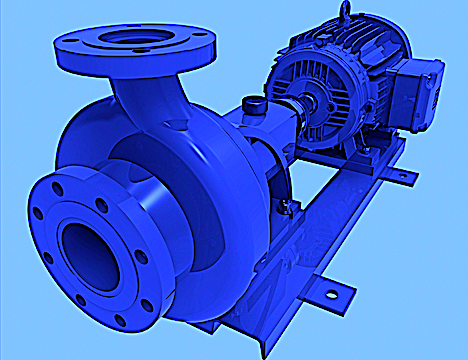Some pump specialists have expressed the belief that process plants are lacking when it comes to applying fundamentals and that chasing after high-tech solutions makes little sense if a plant has not mastered the basics. You can easily check if this notion is true for your plant.
Note: The following dimensional data refer to typical centrifugal refinery pumps and are taken from one of my own books (ISBN 088173-152-7) that was published in 2004). Use this posted version to test your own knowledge and/or that of other staff members at your site. Resist the urge to look up the actual answers (see “fine print” at the end of the quiz) until you’ve selected your own answers to these 20 questions. Give yourself one point for every correct answer. A passing score should be higher than your shoe size.
1. On a 50 mm shaft, preferred radial ball bearing I.D. (bore) to shaft fits are:
(a) 0.0003”-0.0007” interference
(b) 0.0005”-0.0015” interference
(c) 0.0002” loose to 0.0005” interference
(d) 0.0005” loose to 0.0010” interference
2. Using the same 50 mm radial bearing, preferred O.D. to housing fits are:
(a) 0.0001”-0.0009” interference
(b) 0.0005” loose to 0.0005” interference
(c) 0.0001”-0.0015” loose
(d) 0.0010”-0.0025” loose
3. Back-to-back mounted 50 mm thrust bearing I.D. to shaft fits are preferably:
(a) 0.0005”-0.0012” interference
(b) 0.0001”-0.0005” interference
(c) 0.0001”-0.0007” loose
(d) 0.0005” loose to 0.0005” interference
4. Assuming a 50 mm bearing bore, back-to-back mounted thrust bearing O.D. to housing fits are
preferred at:
(a) 0.0010” loose to 0.0005” interference
(b) 0.0005”-0.0015” interference
(c) 0.0001”-0.0015” loose
(d) 0.0015”-0.0026” loose
5. Shaft shoulders at bearing locations must be square with shaft (50 mm) centerlines:
(a) within 0.0001”
(b) within 0.0005”
(c) within 0.005
(d) within 0.010”
6. Shaft shoulder height must be equal to the height of the adjacent bearing inner ring.
(True) (False)
7. Sleeve-to-shaft fits are best if kept within:
(a) 0.0001”-0005” interference
(b) 0.0005”-0.0010” interference
(c) 0.0005” loose to 0.0005” interference
(d) 0.0010”-0.0015” loose
8. Keyed impeller-to-shaft fits, on single-stage, overhung pumps, are preferably:
(a) 0.0000”-0.0005” interference
(b) 0.0005”-0.0010” interference
(c) 0.0000”-0.0005” loose
(d) 0.002”-0.005” loose
9. Impeller to shaft fits, on multistage pumps, sometimes require interference fits and must be checked
against the manufacturer’s specifications.
(True) (False)
10. Keys should be located in keyways with:
(a) 0.0010”-0.0020” looseness
(b) 0.0002”-0.0005” interference
(c) 0.0000”-0.0001” interference
(d) 0.0005” loose to 0.0005” interference
11. For long-term best results and highest reliability, keys should be hand-fitted.
(True) (False)
12. Looking at the following four possibilities (50 mm shaft), assume:
(a) .002”-.003” interference
(b) .015”-.020” clearance
(c) .003”-.006” clearance
(d) .007”-.012” clearance
(A) Select the correct answer for throat-bushing-to-case fit: (a) (b) (c) (d)
(B) Select the correct answer for throat-bushing-to-shaft fit: (a) (b) (c) (d)
(C) Select two (2) correct answers for throat-bushing-to-shaft fits of inline pumps
(depending on shaft size), where throat bushings may act as intermediate bearings:
(a) (b) (c) (d)
13. Looking at the four possibilities listed in question 12 (above), impeller-wear-ring-to-impeller fit
should be as follows:
(a) (b) (c) (d)
14. Impeller wear rings should be secured by:
(a) dowelling
(b) set screws threaded in the axial direction, partly into the impeller and partly into the wear ring
(c) tack-welded in at least two places
(d) any one of these methods: (a) (b) (c) (d)
15. Clearance between impeller wear ring and case wear ring should be 0.010” to 0.012” plus 0.001” per inch up
to a ring diameter of 12 inches. Add 0.0005” per inch of ring diameter over 12 inches.
(True) (False)
16. Referring to question 15 (above), for pumping temperatures of 500 F and over, it is customary to add 0.010.”
Also, whenever wear ring materials with high galling tendencies, such as stainless steel, are used, 0.005” is
added to the clearance.
(True) (False)
17. Impeller wear rings should be replaced whenever the new clearance reaches which of the following multiples
of original values:
(a) 0.005 inches over original
(b) 1.5 times original value
(c) twice original value
(d) three times original value
18. Metallic case wear rings are not to be bored out larger than which of the following percentages of the original
diameter:
(a) 1%
(b) 2%
(c) 3%
(d) 4%
19. Case wear rings made of Vespel CR6100 are suitable for clearances as low as the following percentages of
the opposing impeller eye or shaft diameter:
(a) 1%
(b) 15%
(c) 3%
(d) 5%
20. The allowable axial float of a set of 50 mm back-to-back mounted angular thrust bearings should ideally be:
(a) negative 0.001” to (max) zero
(b) zero to +0.0001”
(c) 0.001”-0.003”
(d) 0.010”-0.015”
ANSWERS:
(1) a; (2) c; (3) b; (4) c; (5) b; (6) False; (7) d; (8) c; ( 9) True; (10) c; (11) True;
(12) A/a, B/b, C/c+d ; (13) a ; (14) d ; (15) True; (16) True; ( 17) c; (18) c; (19) d; (20) c
Editor’s Note: Click Here To Download A Full List Of Heinz Bloch’s 24 Books
ABOUT THE AUTHOR
Heinz Bloch’s long professional career included assignments as Exxon Chemical’s Regional Machinery Specialist for the United States. A recognized subject-matter-expert on plant equipment and failure avoidance, he is the author of numerous books and articles, and continues to present at technical conferences around the world. Bloch holds B.S. and M.S. degrees in Mechanical Engineering and is an ASME Life Fellow. These days, he’s based near Houston, TX.
Tags: reliability, availability, maintenance, RAM, centrifugal pumps, wear rings, bushing, seals, process equipment



